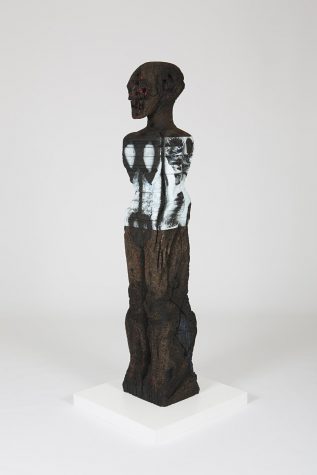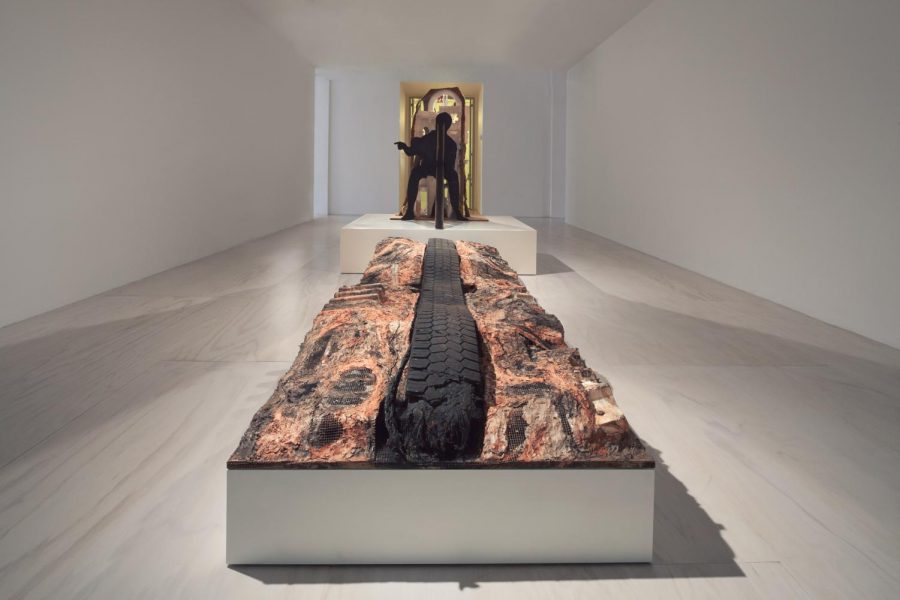Huma Bhabha’s supernatural creations exhibited at ICA
Courtesy Huma Bhabha and Salon 94, New York. © Huma Bhabha
The “Huma Bhabha: They Live” exhibition is on display at the ICA through May 27.
March 27, 2019
Pakistani-American sculptor Huma Bhabha expresses the ethereal and evocative creatures of her imagination in her new exhibition at theInstitute of Contemporary Arts, “They Live.”
The exhibition, which opened Saturday, immerses the viewer in Bhabha’s mind. Godlike statues composed of charred cork stand adjacent to grotesque faces mounted on the wall. Bright colors from neon orange to electric pink illuminate odd creatures. The thick aroma of burning wood wafts throughout the exhibit. Each aspect intends to fully engulf the visitor in the exhibit’s bizarre world.
“This is an exhibition of discrete objects, a show that’s about tactility, and all of your senses are enriched when you’re standing in front of her artworks, even your sense of smell,” said Eva Respini, the Barbara Lee chief curator for the ICA, who organized Bhabha’s exhibition.
Bhabha refers to her figures as hybrids: a blend of human and animal, archaic and industrial, mortal and divine. By incorporating references to a variety of cultures — including pop culture — Bhabha bridges the divide between eras and across civilizations.

Huma Bhabha’s “With Blows,” 2015, is on display at the “Huma Bhabha: They Live” exhibition through May 27.
“Huma uses the word ‘intense’ to describe her work, which I think is accurate,” Respini said. “There is an intensity of materials; the works are mostly made with humble found materials. There’s an intensity of subject, in that the references are wars, colonialism, environmental destruction and narratives of trauma, even apocalypse. And there’s also an intensity of scale.”
The figure is always at the center of what Bhabha does, Respini said. The rooms contain more than 40 sculptures, all composed of various surprising materials. By using chicken wire, everyday Styrofoam or heavy bronze, Bhabha blurs the line between form and void. The sculptures, composed of exposed material, decrepit edges and coarse texture, all intend to emphasize a raw, bare beauty. Yet despite the decaying material, many of the figures evoke a deity-like power.
Bhabha’s work defies the expected. Her figures transcend decades by combining the present with the past. Bhabha’s fascination with sci-fi and horror led her to incorporate multiple allusions to modern media throughout her work. Additionally, Bhabha reflects ancient societies, echoing the rich histories of the Middle East, Greece and Rome, and mirroring attributes from Hindu gods.
“Huma’s work is all about a mix of references. Her sculptures are a synthesis in her interest in art, literature, film, TV and current events,” Respini said.
Bhabha’s work displays duality. One of her most renowned pieces is entitled “Benaam.” This sculpture seems to portray a crouched figure, reaching with outstretched hands and covered with a black shroud. “Benaam,” named after the Urdu word meaning “unarmed,” is meant to memorialize those killed during the war in Iraq and Afghanistan.
Upon closer inspection, the viewer’s interpretation of the sculpture changes. The black material seems to be a trash bag; in reality, it is heavy bronze. Some viewers may interpret the shroud as body bag or burqa, Respini said. The figure’s hands look human, yet it also has a tail. It could be praying, surrendering or dying. The character’s strange and transient form is representative of Bhabha’s style.
“I think in an era where we are increasingly digitized, our bodies and our selves are divorced from the sort of tactile and primal functions that we embody as humans, Huma’s work comes as a matter of urgent necessity,” Respini said. “And this is really, to me, what makes her an artist of our time.”
The exhibition is open at the ICA until May 27.







